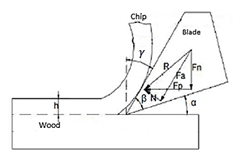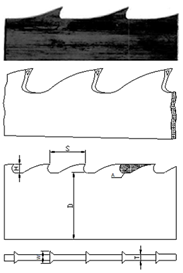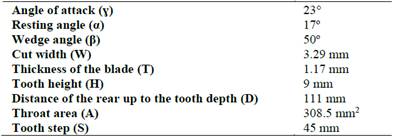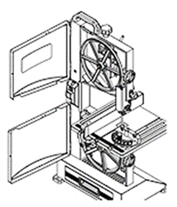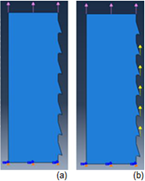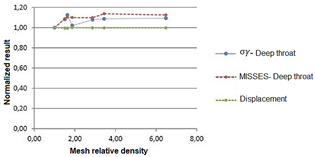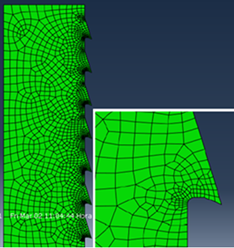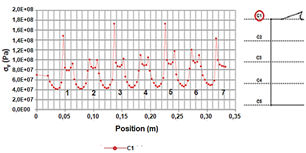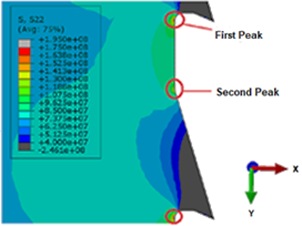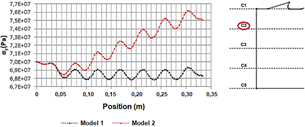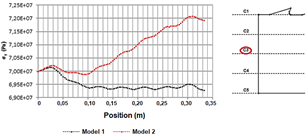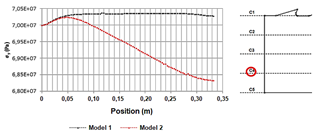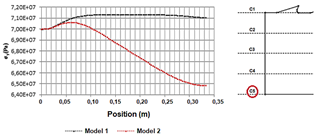1. Introduction
Brazil has large areas of native forests and has a lot of potential for reforestation. In recent years, the timber industry has increased the production of reforestation wood, which has resulted in forest conservation and a reduction in the exploitation of native wood. In Brazil, pine and eucalyptus are good examples of reforestation wood. In 2020, the area with planted forests in Brazil was 9.6 million hectares. Eucalyptus production occupied around 7.4 million hectares, while pinus forests had a total area of 1.8 million hectares, concentrated mainly in the South Region, with 84.6% of the total [1].
After extraction from nature, the wood logs are transported to the lumber mills, when they reach their destination, these logs are usually stored in large yards waiting for processing and processing to begin. The first stage of the processing process consists of splitting the logs using equipment known as a band saw. This equipment is designed to receive logs and make the first cuts, preparing the wood for the following stages of production and processing.
Thus, the Brazilian sawn timber industry, obtained by the direct splitting of logs in saws, with a thickness greater than five millimeters, together with the wood-based panel industry, stands out among the producers of solid wood products. The shapes and dimensions of sawn wood pieces imply different uses, including the production of sleepers, planed and processed wood, beams, planks, spikes, battens and profiles.
The furniture industry is the main destination for this production, followed by civil construction and packaging industries. There are still other sectors that use products from sawn wood, such as wooden artifacts, decoration, handicrafts and pallet manufacturing.
Therefore, the splitting process is the first stage of industrial wood processing, in which the band saw blade used in the sawmill log cutting operation is more advantageous than the circular saw blade. This advantage especially concerns the loss of material. However, despite the smaller thickness of the blade being the reason for less material loss during cutting, on the contrary, it suffers greater instability during the operational process of cutting the wood.
There is research with band saw blades carried out directly in sawmills, which concludes that the number of saw changes per production shift depends on the wear rate of the band saw [2]. To this end, improving the mechanical properties of steel would increase wear resistance, but may increase the cost of the tool [3]. Thus, the application of stress analysis establishing cutting parameters on the tool such as parallel force (Fp) and cutting force (Fc) can contribute to the understanding of wood cutting process.
On a normal working situation (cutting operational process), the tool is susceptible to different type mechanical requests. These requests which are generally, of torsion and of heating due to friction, have its origin from the rotational blade movement when in contact to the wood [4], which are caused by the advance of the wood in the cutting operation.
There are many works about the compromise of the service life of cutting discs caused by complex forces during the operation, the modal analysis of the blades is applied as an analysis method [5]. In the research by Kazimierz [6], he considers the influence of different components of the cutting force on the quality of wood machining, with blades of different thicknesses. The proposal is to develop blades with extremely reduced thicknesses, to reduce the wood residue in the cutting operation.
Already in research for resistance analysis, a 3D model of a circular saw blade was used, later it was loaded with two force components, according to machining theory, these are the components Fc and Fp and then the saw blade was subjected to centrifugal force [7].
The Fig. 1 shows the cutting characteristics of the tool. Being: h = cut depth; ɣ = angle of attack; β= wedge angle; α = exit angle; Fa = Advance force; Fp = parallel force; Fn = Normal force; R = Resulting.
1.1. Purpose
The aim of this work was to develop a numeric model based on the Finite Elements Method to analyze the tensions (σy) at the cutting zone of a saw blade. From the obtained results it is intended to provide subsidies for the study of geometry to the saw teeth. Besides, the fact that is it is also usable for other numerical experiments, which happen to come in occurrence on band saw blade for timber cutting.
In this work, an FEM model is proposed to observe the influence of the cutting force, in the behavior of the tension in the saw blade during the operation and to verify the concentration of tensions in different regions of the tool. Research carried out emphasized working with wood cutting, in which cutting speeds close to 100 m/s were easily achieved in the operation [7].
If the blade cutting speed is extremely higher than the feed speed, in practice, the intensity of the normal force (Fn) is negligible when compared to (Fp). Therefore, the study followed the following criteria:
Develop a model using the Finite Element Method without the application of Fp (Model 1), get a mesh convergence analysis and use it in model 2;
Develop a model using the Finite Element Method with the application of Fp (Model 2);
Analyze the behavior of the longitudinal normal stress σy along the blade.
2. Materials and Methods
In the proposed numerical analysis, a functional instant of the tool was considered for a wood cutting operation [9]. For this, the geometric characteristics of the tool were considered, as well as the mechanical properties of its material and wood, in this case pinus elliottii.
Basic examples of band saw blade tooth shapes are presented in previous works. Parameters such as the tooth pitch, tooth flank length, Gullet depth, the radius of gullet, radius of tooth flank and Blade width can be observed in detail [3].
2.1. Geometrical characteristics of the tool
The tool used for the analysis was a wide saw blade used on the cutting of type c (Fig. 2). The geometry of the band saw blade was determined by digitalization using an Epson Stylus TX133 scanner. The image was processed on the image software for the obtention of the geometrical dimensions [10]. Table 1 presents the entrance data used on the pre-processing of the finite elements model. A steel tool of the SAE 1070 type was used with the following properties [11]: density: 7850 Kg/m3, elasticity module: 200 GPa, and coefficient of Poisson: 0.29.
2.2. Numerical analysis
The numerical analysis was performed by use the commercial software [12]. It was considered a linear elastic analysis with applied stress at the saw teeth. The numerical model was analyzed from different refining mesh levels, up to these results conducted to the satisfactory responses in terms of displacements and strains [13,14]. It was used the Adaptive Remeshing tool from Abaqus function, which allowed to generate several meshes automatically with the refinement according to each area necessity.
In the simulation, only the traction effort imposed by the assembly of the saw blade on the machine was considered. Normally, this tension in the saw is obtained by the positive displacement of one of the flywheels in the vertical direction, responsible for the stretching during assembly on the machine (Fig. 3), obtaining two models with the following, boundary conditions:
Model 1 - Fig. 4 a: The blade was requested in the traction state according to the conditions of assembly on the machine, which resulted in a preloaded model. The result of model 1 was used as a parameter for the second model, to start the simulation with a more representative mesh model.
The boundary conditions of the simulation were defined as follows on the upper part of the saw a tensile stress of 70 MPa was imposed on the assembly according to equation 1 [16], while the lower part was restricted in the three axes (U2=UR1=UR3=0).
Where:
σm = Mounting tension (N/mm²)
FE = Tensile force applied to the free span (N)
b = Blade width (mm)
s = blade thickness (mm)
Fig. 4b: In addition to the same boundary conditions of the first model, a force of 66 N according to equation 2 [8] was applied to each of the five teeth, where the variation of the longitudinal normal stress (σy) was analyzed along the blade, as represented by the imaginary lines in Fig. 5.
Where:
Fp = parallel force
Ks1 = the specific pressure of the material
bc = blade cutting width
hc = sawdust thickness removed per tooth during cutting
1 - z = dimensionless coefficient
The numerical model aimed to present the teeth conditions, at the cut of a pinus elliottii wood piece, with 225 mm height, in the timber cutting operations, of which the five saw teeth work simultaneously.
The numerical simulation with the proposed load as shown in Fig. 4(b) evaluated the variation of the normal longitudinal tension stress (σy), through the saw width (lines C1 to C5), according to Fig. 5.
3. Results and discussions
3.1. Mesh convergence analysis
The type of the mesh has a direct effect on the accuracy and time of the calculation. Therefore, the chosen element size must be considered during mesh generation. If the size of the selected element is too large, the simulation result will hardly reach the real condition. However, if the size of the selected element is too small, the calculation cost will increase significantly [17]. Therefore, it is necessary to compare the calculation accuracy and calculation speed during mesh generation.
In a study to obtain the equivalent radial stress in a circular saw blade, a model was proposed using the finite element method with the Abaqus software. The 4-node bilinear plane stress quadrilateral element CPS4R was chosen for analysis of the saw blade.[18].
Table 2 and Fig. 6 show the results of mesh convergence evaluation from the finite elements, considering the different mesh densities. It was observed, from Table 2 data that the best results of convergence were obtained with 2011 discretized elements.
Table 2 Convergence results analysis
| Global size | Nº elements | σy (Pa) | Misses (Pa) | Dislocation (m) |
|---|---|---|---|---|
| 0.017 | 701 | 1.39 E+08 | 1.42 E+08 | 5.24 E+05 |
| 0.017 | 1054 | 1.51 E+08 | 1.54 E+08 | 5.22 E+05 |
| 0.01 | 1145 | 1.57 E+08 | 1.56 E+08 | 5.21 E+05 |
| 0.01 | 1308 | 1.42 E+08 | 1.56 E+08 | 5.24 E+05 |
| 0.005 | 2011 | 1.50 E+08 | 1.56 E+08 | 5.23 E+05 |
| 0.005 | 2412 | 1.51 E+08 | 1.61 E+08 | 5.23 E+05 |
| 0.003 | 4545 | 1.52 E+08 | 1.59 E+08 | 5.23 E+05 |
Source: Prepared by author, 2022.
Important information was obtained from the application of cutting forces at the highest points of the saw teeth [9], because this region of the tooth penetrates the wooden piece first. Thus, due to the reduced geometry in the upper region of the tooth, the mesh needed to be refined as in this work.
The Fig. 7 presents the result of Model 1, whose mesh was selected for model 2.
3.2. Fp Influence
The Fig. 8 shows the variation of the tension stress (σy) through the C1 line (Fig. 5).
It was observed that σy presented an oscillatory behavior. The first tension stress peak occurred at the inferior extremity of the teeth throat, and the second peak at the beginning of the next tooth as expected. Fig. 9 shows the tensions stress distribution at the tooth.
The first tension stress peaks had a value between 140 MPa to 100 MPa. These values had not been significant for the tool failure. Fig. 10 shows a tension stress variation σy through the blade (along C2).
Previous studies with simulation analysis of wood cutting with PCD circular saw blades using the finite element method were established in recent research [19]. The best cutting parameters of the PCD circular saw blade for wood were verified. After several experiments, they concluded that the maximum shear stress acting on the blade is relatively low.
It was observed an undulating behavior of the σy tension, nevertheless with not much variation as seen in C1. This has occurred due to the C2 line become further than the tooth throat. Fig. 11 shows a variation of σy in C3 line. The greatening of the σy tension stress had a linear behavior.
Fig. 12 shows a variation of σy in C4 line. Thus, compression stress was observed in this part of the tool.
Fig. 13 shows the graphic of the tension σy along line C5, for which it was also observed a value reduction of σy compression stress observed in Fig.s (12-13), that occurred by the fact that, in both C4 and C5 lines, were located between the back and the central line of the tool. The compression stress appears as to compensate the caused tension by the cutting stress.
From the observations of Figs. (10-13), it was verified that, despite the model suffering a tension stress of 70 MPa in one of its extremities, the σy values were above for the C4 and C5 values, and below of 70 MPa for C2 e C3.
Research associated with the wear of saw blade teeth when cutting wood was also carried out, to verify whether the intensity of the cutting force is affected. The purpose of the work was to compare values obtained in practice, with theoretical values obtained by the finite element method [20]. The results of the experiment show that the parameters (cutting speed and feed speed) are not significant in increasing the cutting force, as well as in the observations of the equivalent stress, which varied between 14 MPa and 22 MPa between theory and practice.
4. Conclusions
The methodology used allowed us to obtain a model using the finite element method without the application of (Fp), in this case model (1), which only considered the normal stretching of the blade imposed by the assembly on the machine. In this way, the best mesh convergence and a pre-loaded model for use in model (2) were obtained. An FEM model was also developed with the application of (Fp), with model (2) it was possible to analyze the stresses (σy) in the cutting zone of a saw blade. From this numerical model, it was possible to identify the influence of the parallel cutting force (Fp) on (σy), and the concentration of tensile stresses was observed at two main points, at the lower end of the throat and at the initial part of the tooth. The concentration of tensile stresses can influence the useful life of the saw blade, but the result can guide future studies with tooth geometry.
The numerical model used can be worth to the development of another, and more sophisticated numerical models, once considered the non-linearities behavior for the material and saw blade composition.
Finally, the study allowed the construction of a numerical model capable of quantifying the tensile stresses in a wide saw blade, for cutting pinus elliottii.














